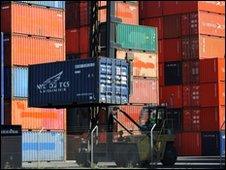Scottish firms 'miss a trick' on exports
- Published

Almost 25% of exporting firms are targeting business in the Far East
Only one in three of Scotland's small and medium sized companies are exporting, and few of the others have plans to change that, a poll has found.
A fifth of firms surveyed by the Bank of Scotland said language barriers were among the biggest obstacles to exporting.
The recent disruption from volcanic ash is seen as another reason for not planning to look for markets overseas.
One of the bank's directors said such companies were "missing a trick".
Markets overseas
Donald Kerr said: "While exporting may have traditionally been seen as only suitable to companies in industries such as manufacturing, firms operating in other sectors have the opportunity to explore new markets and assess international demand for their products.
"At a time when demand is subdued, thousands of small firms could still benefit from markets overseas.
"Although traditional markets in Europe and the US will remain the main targets for most firms, there is real potential across the Middle East and Asia, which is as yet untapped."
However, more than two in five companies reported that a fear of demand was the main reason for not looking to markets overseas.
The same proportion feared their bad debts would not be paid, and almost as many feared foreign currency fluctuations.
The survey found that of the third of companies that were exporting, more than one in three have experienced growth in that part of their business. Few of them expected the export share of business to fall.
Of those companies that were exporting from Scotland, almost a quarter hoped to build business in China and the Far East, and almost a fifth saw opportunities in Africa and the Middle East, while Europe and North America remained the dominant markets.
Meanwhile, another survey of Scotland's international activities showed it had continued to outperform most other parts of the UK in attracting foreign investment.
It continued to have the third highest number of companies choosing to locate business in Britain, after London and south east England.
London remained hugely dominant, with more than two-thirds of all inward investment decisions. It had 263 inward investment projects included in the survey, whereas Edinburgh and Glasgow each had seven, and all of Scotland had 51.
The Ernst & Young survey showed how far inward investment has fallen as a source of new jobs.
Ten years ago, more than 60,000 jobs were created in Britain through foreign direct investment.
Inward investment
Last year was the second consecutive year with only 20,000 jobs being created that way through new projects or expansions.
The UK continued to dominate inward investment within Europe, having 30% of business service projects, 36% of software projects and 27% of financial sector projects within western Europe.
That is attributed to its dominance of projects coming from US companies. America also represents more than two-thirds of projects coming to the UK, followed by France and Germany. India had the fourth largest number of investments in Britain, with 38 projects.
Other large European nations held their share of inward investment, but Ireland and Spain saw steep falls.
So did the newer members of the European Union, such as Poland, Hungary, Romania and the Czech Republic, which had previously seen manufacturing plants being located where wages are lower.
But with the downturn, the number of such investments last year fell 40% in those countries.
James Close, of Ernst & Young, said: "When seen in the context of 12 months during which the European economy suffered a deep recession, the resilience of the UK in securing FDI is a remarkable economic success story."